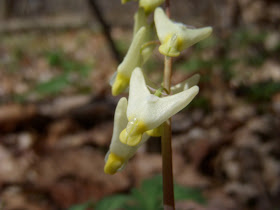At Sebert County Park, I stumbled across American Dog Violet (Viola conspersa). This handsome blue violet is uncommonly encountered in moist woods, mostly east of the Mississippi River.
 Limestone Bittercress (Cardamine douglassii) was flowering at Spicer Lake Nature Preserve. This plant of the mustard family (Brassicaceae) is commonly found in moist woods, often in somewhat disturbed areas.
Limestone Bittercress (Cardamine douglassii) was flowering at Spicer Lake Nature Preserve. This plant of the mustard family (Brassicaceae) is commonly found in moist woods, often in somewhat disturbed areas. The flowers of Limestone Bittercress have four petals, characteristic of mustards. This species is similar in appearance to Bulbous Bittercress (Cardamine bulbosa), but as you'll notice in the photograph below the stem within and below the inflorescence is pubescent, while that of Bulbous Bittercress has no hairs. There are also habitat differences, as Bulbous Bittercress is more often found in springy areas.
The flowers of Limestone Bittercress have four petals, characteristic of mustards. This species is similar in appearance to Bulbous Bittercress (Cardamine bulbosa), but as you'll notice in the photograph below the stem within and below the inflorescence is pubescent, while that of Bulbous Bittercress has no hairs. There are also habitat differences, as Bulbous Bittercress is more often found in springy areas. Also at Spicer Lake, Virginia Strawberry (Fragaria virginiana) had begun to flower on trails through an old-field. I later saw this somewhat weedy species, which can be found throughout North America, flowering on the trails on our property. This is a welcome site for Bootypants, who thoroughly enjoys plucking the Virginia Strawberry fruit right off of the plants as we walk our trails during the summer.
Also at Spicer Lake, Virginia Strawberry (Fragaria virginiana) had begun to flower on trails through an old-field. I later saw this somewhat weedy species, which can be found throughout North America, flowering on the trails on our property. This is a welcome site for Bootypants, who thoroughly enjoys plucking the Virginia Strawberry fruit right off of the plants as we walk our trails during the summer. Bendix Woods will probably be at its peak for wildflower viewing next weekend, when I will be leading a hike there for Shirley Heinze Land Trust. However, several ephemerals were already in bloom on Saturday. One of those was Wild Ginger (Asarum canadense), which is found in moist woods throughout eastern North America.
Bendix Woods will probably be at its peak for wildflower viewing next weekend, when I will be leading a hike there for Shirley Heinze Land Trust. However, several ephemerals were already in bloom on Saturday. One of those was Wild Ginger (Asarum canadense), which is found in moist woods throughout eastern North America. The 1-inch long flowers of this gorgeous species are hidden below the leaves very close to the ground, and can be easily overlooked if you aren't specifically looking for them.
The 1-inch long flowers of this gorgeous species are hidden below the leaves very close to the ground, and can be easily overlooked if you aren't specifically looking for them. Lindsay recently talked about seeing Dutchman's Breeches (Dicentra cucullaria) in this post; on Saturday at Bendix Woods, I saw the closely related Squirrel Corn (Dicentra canadensis) just beginning to flower. The flowers of Squirrel Corn often have a soft pinkish tinge to them. The plant is named Squirrel Corn because of the tuberous roots, which are yellow and look like kernals of corn.
Lindsay recently talked about seeing Dutchman's Breeches (Dicentra cucullaria) in this post; on Saturday at Bendix Woods, I saw the closely related Squirrel Corn (Dicentra canadensis) just beginning to flower. The flowers of Squirrel Corn often have a soft pinkish tinge to them. The plant is named Squirrel Corn because of the tuberous roots, which are yellow and look like kernals of corn. I really do enjoy seeing this next plant every spring. This is False Mermaidweed (Floerkea proserpinacoides), a plant of moist woods that is very easily overlooked and somehow often confused with bedstraw (Galium sp.).
I really do enjoy seeing this next plant every spring. This is False Mermaidweed (Floerkea proserpinacoides), a plant of moist woods that is very easily overlooked and somehow often confused with bedstraw (Galium sp.). The tiny flowers of this species have three whitish petals. You want to amaze your friends? Find False Mermaidweed in mid- to late-April and show them the beautiful flowers. Trust me... they'll be amazed. In the United States, this species is found as far east as Massachusetts and as far west as California.
The tiny flowers of this species have three whitish petals. You want to amaze your friends? Find False Mermaidweed in mid- to late-April and show them the beautiful flowers. Trust me... they'll be amazed. In the United States, this species is found as far east as Massachusetts and as far west as California. And from one spring wildflower with three white petals to another...
And from one spring wildflower with three white petals to another... This is White Trillium (Trillium grandiflorum), of the lily family (Liliaceae). White Trillium is the state wildflower of Ohio, and it's easy to see why. I've never come across someone in the woods who isn't completely enamored with this species. As the season progresses, the petals begin to turn pink. Next week, Bendix Woods should be a carpet of white, made up in large part by White Trillium.
This is White Trillium (Trillium grandiflorum), of the lily family (Liliaceae). White Trillium is the state wildflower of Ohio, and it's easy to see why. I've never come across someone in the woods who isn't completely enamored with this species. As the season progresses, the petals begin to turn pink. Next week, Bendix Woods should be a carpet of white, made up in large part by White Trillium. Finally, I came across this little insect that I believe is a Click Beetle, though I have no idea to what genus or species it belongs. From what I understand, they are called "click beetles" because of their ability to snap two body parts together, which shoots them into the air to avoid predators.
Finally, I came across this little insect that I believe is a Click Beetle, though I have no idea to what genus or species it belongs. From what I understand, they are called "click beetles" because of their ability to snap two body parts together, which shoots them into the air to avoid predators. This Click Beetle was perched on the spike of Plantainleaf Sedge (Carex plantaginea). If anyone can help with a positive identification of the insect, I would be love to know what it is.
This Click Beetle was perched on the spike of Plantainleaf Sedge (Carex plantaginea). If anyone can help with a positive identification of the insect, I would be love to know what it is.By the way, the ticks are out, so watch yourself. Bootypants and I are tied at two each; Lindsay hasn't had any yet.

































